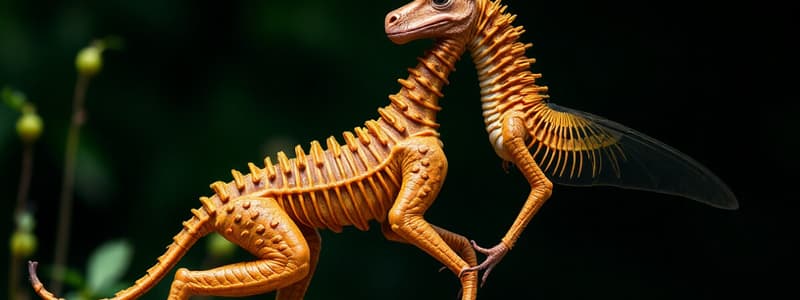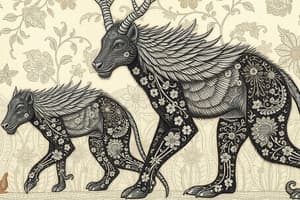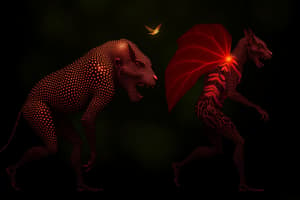Podcast
Questions and Answers
What is selection?
What is selection?
Selection is the non-random differential survival or reproduction of organisms.
Sexual selection is different from natural selection.
Sexual selection is different from natural selection.
True (A)
Which of the following are types of selection? (Select all that apply)
Which of the following are types of selection? (Select all that apply)
- Sexual selection (correct)
- Natural selection
- Directional selection (correct)
- Disruptive selection (correct)
- Artificial selection (correct)
- Stabilizing selection (correct)
What does sexual selection maximize?
What does sexual selection maximize?
All selections are considered natural selection.
All selections are considered natural selection.
Sexual selection is a process through which both males and females attempt to maximize their chance of ______.
Sexual selection is a process through which both males and females attempt to maximize their chance of ______.
Is sexual selection a type of natural selection?
Is sexual selection a type of natural selection?
Flashcards
Sexual Selection
Sexual Selection
A type of natural selection where individuals with traits that improve their ability to attract mates or compete for mates pass on their genes more successfully.
Natural Selection
Natural Selection
The process where organisms with traits better suited to their environment are more likely to survive and reproduce, passing on these traits.
Directional Selection
Directional Selection
A type of natural selection where an extreme phenotype is favored over other phenotypes, causing the population to shift towards that extreme
Disruptive Selection
Disruptive Selection
Signup and view all the flashcards
Stabilizing Selection
Stabilizing Selection
Signup and view all the flashcards
Artificial Selection
Artificial Selection
Signup and view all the flashcards
Reproductive Success
Reproductive Success
Signup and view all the flashcards
Fitness (in evolution)
Fitness (in evolution)
Signup and view all the flashcards
Mate Choice
Mate Choice
Signup and view all the flashcards
Sexual Selection Mechanisms
Sexual Selection Mechanisms
Signup and view all the flashcards
Study Notes
### Comparative Vertebrate Biology - Sexual Selection
- Lecture Topic: Sexual Selection
- Lecturer: Dr Joanna Baker
- Date: Tuesday 29th October, 2023
- Time: 17:00-17:55
What is Selection?
- Selection is the non-random differential survival or reproduction of organisms.
- Darwin defined it as "the principle by which each slight variation [of a trait], if useful, is preserved."
Lecture Objectives
- Define sexual selection and differentiate it from natural selection.
- Explain key mechanisms of sexual selection in vertebrates.
- Provide examples of sexual selection across vertebrates.
Lecture Outline
- Types of selection (directional, disruptive, stabilizing, sexual, artificial)
- Mechanisms and examples of sexual selection (same-sex contests, mate choice, intrasexual selection, intersexual selection, coercive mating, sperm competition)
- Evolutionary consequences (sexual dimorphism, alternative mating strategies, sexual conflict, human evolution)
- Interactive discussion
- Conclusions
Types of Selection
- Directional selection: Favors one extreme of a trait over the other. Example: Giraffe necks lengthening.
- Disruptive selection: Favors both extremes of a trait over the intermediate. Example: Light and dark moths.
- Stabilizing selection: Favors the average or intermediate trait. Example: Mouse fur color.
- Sexual selection: Based on an organism traits appeal to the opposite sex or competition with same sex
- Artificial selection: Deliberate selection by humans of a chosen trait or set of traits. Example: Dog breeds.
Mechanisms of Sexual Selection
- Same-sex contests: Competition among males. Example: Male elephant seals fighting for females. Male Elk competing for mates.
- Scramble competition: Competition to locate and acquire mates.
- Endurance rivalry: Competition based on stamina.
- Sperm competition: Competition among sperm to fertilize an egg. High in species with multiple males.
- Coercion: Forcing copulation.
- Mate choice: Example: Female choice of colourful male birds, males advertising their "fitness."
Evolutionary Consequences of Sexual Selection
- Sexual dimorphism: Observable differences between males and females of a species due to selection pressure. Example: Peacocks, deer antlers.
- Alternative mating strategies: Different mating behaviours within a species. Example: Sneaker males in swordtails.
- Sexual conflict: Evolutionary struggle between the sexes due to conflicting reproductive strategies. Example: Coercive mating in waterfowl.
- Human evolution: Darwin, human beauty standards. Evidence suggests the effects are small but not zero.
Additional Points
- Sexual selection is a component of fitness and a potential driver of evolutionary changes.
- The specific traits influenced by sexual selection vary greatly across species.
- There are examples of mate choice "runaway" selection where preference and the trait related are linked in a positive feedback loop.
Further Reading
- Hosken & House (2011), Current Biology
- Catchpole (1987), Trends in Ecology & Evolution
- O'Brien et al, Animal Behaviour
- Schlupp (2018), Current Zoology
- Parker & Pizzari (2010), Biological Reviews
- Wigby & Chapman (2004), Current Biology
- Brennan et al (2009), Proceedings of the Royal Society B
- Domb & Pagel (2001), Nature
- Snow & Prum (2023)
- Bahr et al (2012), Behavioural Ecology
- Carballo et al (2019), J Evolutionary Biology)
Studying That Suits You
Use AI to generate personalized quizzes and flashcards to suit your learning preferences.




